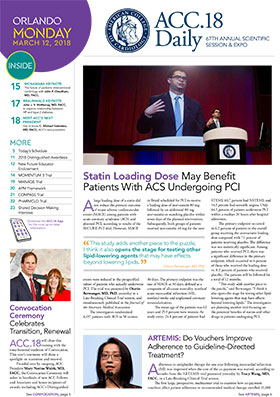Shared Decision Making For the Clinician: From Buzzword to Bedside
The focus on shared decision making in medicine has grown dramatically. Several factors have contributed to increased physician awareness of the need to incorporate patient preferences in medical decision making over the last nearly two decades. Among these are the Institute of Medicine’s 2001 report titled Crossing the Quality Chasm, passage of the Affordable Care Act in 2010, and more recently new requirements by the Centers for Medicare and Medicaid Services for use of shared decision making prior to some procedures.
“I think Medicare is reflecting an underlying trend in medicine to recognize that health care is ultimately about patients. Medical decisions about their care are better when patients are engaged in the process,” says Larry A. Allen, MD, FACC, co-chair of the Intensive.
"I think Medicare is reflecting an underlying trend in medicine to recognize that health care is ultimately about patients. Medical decisions about their care are better when patients are engaged in the process." — Larry A. Allen, MD, FACC
With this increasing importance of shared decision making in cardiology practice, today’s Intensive – Shared Decision Making for the Clinician: From Buzz to Bedside – is designed to provide attendees with a general understanding of shared decision making and the underlying science; a “how to” for developing and implementing patient decision aids; and a review of existing resources and available patient decision aids.
The Intensive consists of two interactive sessions and a visit to posters on relevant research. Shared decision making champion Harlan M. Krumholz, MD, SM, FACC, will kick it off with a talk on his assessment of shared decision making’s current place in cardiology and where we need to go.
An expert panel will also present four case studies that will highlight issues fundamental to understanding shared decision making; the development, efficacy and implementation of decision aids; and the role policy might play in shared decision making. “Case studies have been incorporated into the session to help show how clinicians have applied the principles to individual clinical scenarios,” says Allen. Discussion and audience questions are key to making this relevant to attendees. An introduction to the poster session will set the stage for the mid-intensive “field trip” to the moderated poster session theater.
ACC President Mary Norine Walsh, MD, FACC, will shift the focus to implementing shared decision making in practice with her talk on the process of bringing it to the mainstream. Next up will be developers presenting real-world examples of cardiovascular patient decision aids for use in specific cardiovascular conditions, including atrial fibrillation stroke prevention, statin choice, destination therapy left ventricular assist device and ICD use.
Allen and co-chair, Colleen Kelley, MD, will present information on where to find decision aids, including online, that communicate risks, benefits and concerns in fair and optimal ways. “There’ll be lots of examples of decisions for attendees to experience first-hand,” says Allen. Additionally, an expert panel will address issues surrounding the implementation of patient decision aids in clinical practice.
Keywords: ACC Publications, ACC Scientific Session Newspaper, ACC Annual Scientific Session
< Back to Listings

